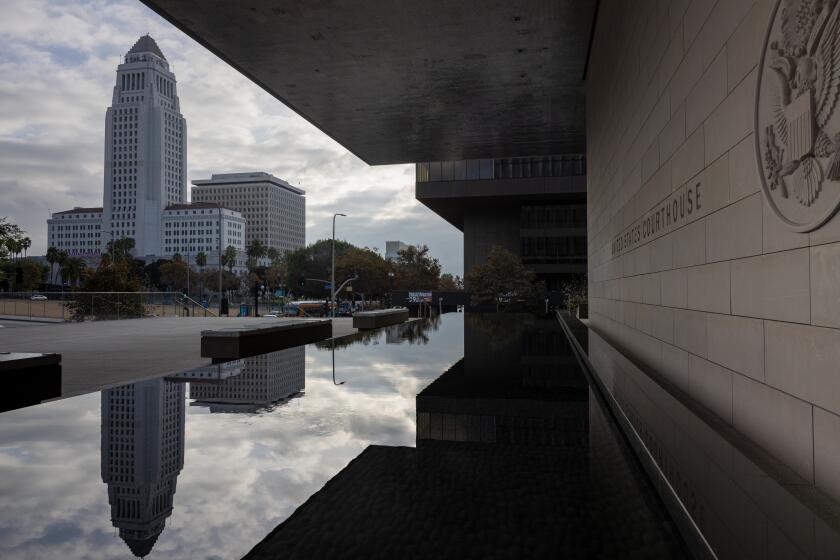California population growth hits record lows, stifled by COVID-19 and continued exodus

- Share via
After more than three decades, Scott Fuller was fed up with living in California.
The taxes are just too darn high, he said. The housing prices too. And so in June, the San Francisco Bay Area real estate broker, his wife and two kids packed their bags and moved to Arizona.
“I never wanted to leave California,” said Fuller, 48, who has lived in the Golden State since 1983. “It’s the most beautiful state with the best climate. I think the tipping point was continued tax increases and even more proposed tax increases.... I have absolutely no regrets.”
Like Fuller, a lot of Californians are running for the exit, a trend exacerbated this year by COVID-19 as more people moved away and pandemic restrictions slowed migration into the state, according to data released Wednesday.
California’s population is now growing at its slowest rate in more than a century.
The California Department of Finance, which monitors the state’s population data, found that from July 1, 2019 to July 1, 2020, California saw a net gain of only 21,200 new residents — a 0.05% growth rate not seen since 1900. As of July, the state’s population was 39.78 million.
Over that period, Los Angeles County reported a net loss of 40,036 people, more than any other county in the state.
“This is a real sea change in California, which used to be this state of pretty robust population growth,” said Hans Johnson, a demographer at the Public Policy Institute of California. “It hasn’t been for some time now. But it’s now gotten to the point where the state is essentially not growing population-wise at all.”
The data underscore concerns that the COVID-19 pandemic is fueling greater migration out of California, both from people priced out of coastal areas and those who suddenly had the ability to work remotely.
The “California exodus” storyline was bolstered in recent weeks when two tech titans, Elon Musk and Larry Ellison, announced they were moving to Texas and Hawaii, respectively.
But for the average person, California’s high housing costs pose the greatest challenge, particularly when combined with staggering job losses tied to the pandemic.
The state has been seeing slowing growth for several years, driven by a factors that include lower birth rates and people moving away for economic and political reasons.
COVID-19 has affected the trend in several ways.
About 280,000 Californians died during the 12-month period, representing a higher-than-average surge, year over year. That is due partly to the state’s aging population, the report said, and partly to COVID-19, which had killed more than 6,000 Californians by July.
The pandemic also affected immigration, said H.D. Palmer, a spokesman for the Department of Finance. As the virus raged, work patterns dramatically shifted and many international borders were closed.
“A lot of people who might otherwise have come to California didn’t, because they didn’t go anywhere,” Palmer said. “They stayed home. That’s something that’s different than any other year.”
Birth rates also continued to decline, with 14,000 fewer babies born than in the same period last year, according to the report.
“That’s a significant decline from 2019,” said Walter Schwarm, the state finance department’s chief demographer. “And if we go back five or 10 years, in terms of growth, that’s 70,000 Californians that aren’t here.”
Many millennials are delaying childbirth, Schwarm said, while Gen Xers have mostly stopped giving birth and Gen Z is “not quite there yet.”
Of the 10 most populous counties in California, seven saw a drop in residents: Los Angeles, San Diego, Orange, San Bernardino, Santa Clara, Alameda and Contra Costa. Riverside, Sacramento and Fresno counties saw population gains.
Most of California’s coastal counties lost population.
By contrast, several inland counties — including El Dorado, Glenn, Yuba and Merced — saw population growth during this period, a trend Palmer attributed to housing availability and affordability, as well as lifestyle changes that could drive people to seek out different areas.
Although rural areas have been losing residents for years, primarily because of a lack of jobs, the recent loss of residents in urban areas is especially noteworthy, Johnson said.
“Its no longer just the small rural counties that are losing population,” he said, adding that housing costs are one of the primary factors.
If the trends continue statewide and California’s population decreases, one of the most immediate effects could be the loss of a seat in Congress, Johnson said.
Wildfires also played a role in population changes, the report said.
Butte County, which was ravaged by the 2018 Camp fire, lost population over the 12-month period, although the magnitude was slower than the previous year, according to the report. In September, the county suffered again in the North Complex fire. Any population losses from that will be reflected in next year’s report.
There have been large out-migrations from Southern California in the past, Palmer said, including a period in the early 1990s tied to the collapse of the defense and aerospace industries. The current shift is reflective of a downward trend that began around 2016.
Although growth rates are slowing, Palmer and Schwarm both said that California remains a desirable place to live, as evidenced by the record high home prices reached this year.
And yet, so many Californians are leaving that Fuller caters specifically to them. Three years ago, the longtime real estate broker created two websites: LeavingTheBayArea.com and LeavingSoCal.com. He has kept busy.
His clients are retirees and working families who can’t afford to remain in the Bay Area. They are people fleeing wildfire risk. And increasingly, they are affluent people moving to states with low or no income tax.
Some of the most popular locations, he said, are Austin, Texas; Dallas; Boise, Idaho; and Phoenix. In a typical month, he and his team of real estate agents help to relocate 15 to 18 families out of California, and “we’re certainly seeing an increase in people exploring their options.”
Even though his team is still based in the Bay Area, he now works remotely from Arizona. The pandemic forced more companies to let their employees work from home, and that has been “one of the biggest dynamics changes” for people who were already considering leaving California, he said.
If people can keep the same salary and work in a cheaper location, Fuller said, they’re jumping at the opportunity. The trend started before COVID, he said, but the pandemic sped up the process. People considering moving in three to five years are now moving in one to two.
“It’s really sped up the out-migration quite a bit,” Fuller said. “People have options now, and you pair that with people’s frustration on several different levels — I don’t see it changing.”
More to Read
Sign up for Essential California
The most important California stories and recommendations in your inbox every morning.
You may occasionally receive promotional content from the Los Angeles Times.












